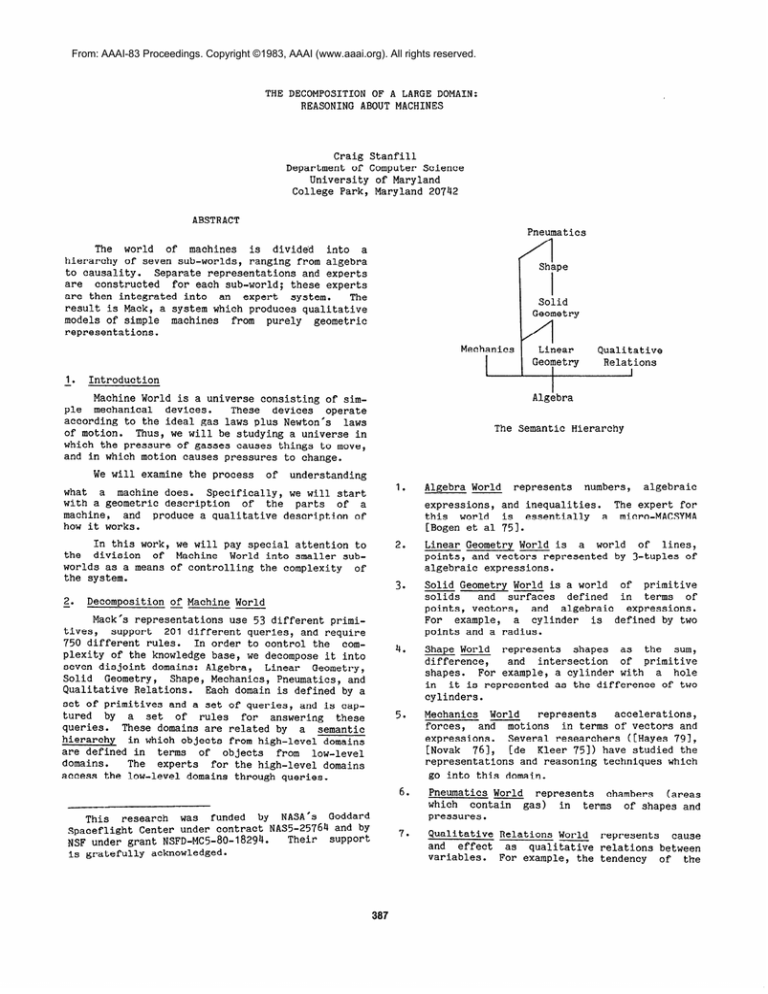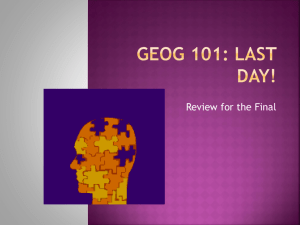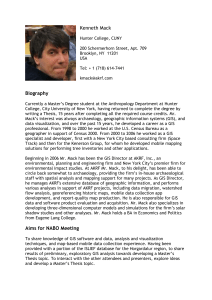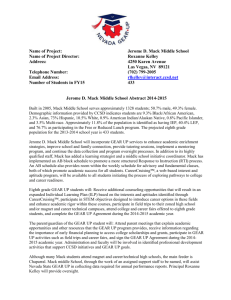
From: AAAI-83 Proceedings. Copyright ©1983, AAAI (www.aaai.org). All rights reserved.
THE DECOMPOSITION OF A LARGE DOMAIN:
REASONING ABOUT MACHINES
Craig Staafill
Department of Computer Science
University of Maryland
College Park, Maryland 20742
ABSTRACT
Pneumatics
The world of machines is divided into a
hierarchy of seven sub-worlds, ranging from algebra
to causality. Separate representations and experts
are constructed for each sub-world; these experts
are then integrated into an expert system.
The
result is Mack, a system which produces qualitative
models of simple machines from purely geometric
representations.
I
Mechanics
1
-*
Introduction
Machine World is a universe consisting of simple mechanical devices.
These devices operate
according to the ideal gas laws plus Newton's laws
of motion. Thus, we will be studying a universe in
which the pressure of gasses causes things to move,
and in which motion causes pressures to change.
We will examine the process of
I
Solid
Geometry
Linear
Geometry
Qualitative
Relations
Algebra
The Semantic Hierarchy
understanding
what a machine does. Specifically, we will start
with a geometric description of the parts of a
machine, and produce a qualitative description of
how it works.
In this work, we will pay special attention to
the division of Machine World into smaller subworlds as a means of controlling the complexity of
the system.
2.
i’
Shape
1.
Algebra World represents numbers, algebraic
-expressions, and inequalities. The expert for
this world is essentially a micro-MACSYMA
[Bogen et al 751.
2.
Linear Geometry World is a world of lines,
points, and vectors represented by 3-tuples of
algebraic expressions.
39
-Solid Geometry World is a world of primitive
and surfaces defined in terms of
solids
points, vectors, and algebraic expressions.
For example, a cylinder is defined by two
points and a radius.
4.
Shape World represents shapes as the sum,
-difference, and intersection of primitive
shapes. For example, a cylinder with a hole
in it is represented as the difference of two
cylinders.
5.
represents accelerations,
Mechanics World
forces, and motions in terms of vectors and
expressions. Several researchers ([Hayes 791,
[Novak 761, [de Kleer 751) have studied the
representations and reasoning techniques which
go into this domain.
Decomposition --of Machine World
Mack's representations use 53 different primitives, support 201 different queries, and require
750 different rules. In order to control the complexity of the knowledge base, we decompose it into
seven disjoint domains: Algebra, Linear Geometry,
Solid Geometry, Shape, Mechanics, Pneumatics, and
Qualitative Relations. Each domain is defined by a
set of primitives and a set of queries, and is captured by a set of rules for answering these
queries. These domains are related by a semantic
hierarchy in which objects from high-level domains
are defined in terms of objects from low-level
domains.
The experts for the high-level domains
access the low-level domains through queries.
This research was funded by NASA's Goddard
Spaceflight Center under contract NAS5-25764 and by
NSF under grant NSFD-MC5-80-18294. Their support
is gratefully acknowledged.
387
6.
Pneumatics World represents chambers (areas
which contain gas) in terms of shapes and
pressures.
7.
Qualitative Relations World represents cause
and effect as qualitative relations between
variables. For example, the tendency of the
gas in a chamber to cause a piston to move is
represented by a relation between the pressure
of the gas and the acceleration of the piston.
The formulation which is used by Mack is
derived from Ken Forbus's Qualitative Process
theory [Forbus 821 and other qualitative reasoning schemes ([Kuipers 821 [de Kleer 753).
This architecture separates knowledge about
how to create models from knowledge about representation. This is important for the conduct of
experiments: we tend to modify the techniques used
to create the models as we learn more about understanding machines, but the representations which we
use and the queries which we ask about those
representations are relatively stable.
It is worth noting that many of the domains
mentioned above have already been studied. These
earlier systems are superior to Mack within their
own fields; the problem which Mack solved was
integrating these representations. This ability to
build on existing representations is one advantage
of Mack's domain oriented architecture.
We will now consider the actual sequence of
models which Mack produces in the course of understanding a machine. This sequence of models is
related by the following epistemological hierarchy,
in which high-level models are inferred from lowlevel models.
Another advantage of this architecture is that
it provides a good guide for the construction of
the experts. For example, when we decide to create
an Algebra expert, we have a good idea of what
needs to go into it: we will need primitives for
representing expressions, procedures for simplifyThus,
ing them, and some means of comparing them.
we can determine what primitives we will need, what
queries we will need to support, and we know when
we have written enough rules.
Another advantage of this architecture is that
it allows us to experiment with representations.
There are many cases where, in the course of system
development, we find that our representations are
inadequate. Because the internal structure of the
representations are hidden from the other domains,
we need only modify the faulty domain.
Static
The Epistemological Hierarchy
Finally, by decomposing a domain we learn
about its structure. For example, we decomposed
Machine World into these seven sub-domains, and
found that a simple relation - the semantic hierarchy - described its structure. We have also examined (in work not fully reported here) the 'fine
structure' of some of these domains. For example,
Mathematics is composed of a series of 'layers':
Arithmetic, Algebra, Trigonometry, and so forth;
each of these layers is an extension of the one
that lies under it. We have also probed the role
of foundational knowledge, such as knowledge about
such
knowledge
is
logic, by examining how
integrated into the system. These topics are fully
developed in [Stanfill 831.
3.
Mack begins with a description of shape of the
parts of the machine. This is the -Static Model of
the machine.
From this, it constructs a model of how the
parts of the machine can move. These motions are
derived from the manner in which these parts touch.
Mack discovers that the piston touches the block in
a cylindrical surface, which allows the it to slide
left to right and to rotate about its axis. Mack
then creates variables, X-l
and
THETA-l,
to
parameterize these motions.
The result is the
Kinematic Model of the machine.
Comprehension
In order to comprehend a machine, Mack constructs a sequence of progressively more abstract
Specifically, Mack
descriptions of the machine.
starts with a description of the shapes of the
parts of the machine, and produces an abstract,
qualitative model of the machine. To do this, it
describing motions,
forces,
creates
models
chambers, and accelerations.
We implement this reasoning strategy as a set
of model experts, each of which knows how to create
a specific model. Model creation proceeds in four
steps.
First, the model expert obtains any lowlevel models on which it depends. Next, it asks
representation experts to extract features from
these lower level models. Next, the expert examines these features and constructs a set of objects
for its model. Finally, the representation expert
for these new objects simplifies the model.
THETA-I
X-l
Mack next models the behavior of gasses in the
Machine.
Any area which is not occupied by a part
388
of the machine is assumed to contain gas.
Thus,
Mack discovers two disjoint areas which contain
isas, and models each of these as a separate
chamber.
The result is the Pneumatic Model of the
machine.
This example took 5 minutes on a VAX 11/78O
with 4 M-bytes of memory, running Franz Lisp under
The
the Berkeley 4.1 Unix (tm) operating system.
following mechanisms have also been understood by
Mack:
Mack now constructs a model of forces due to
the pressures of gasses. It does this by finding
the surface where each part in the Static Model
touches a chamber in the Pneumatic Model. For each
such surface, it infers a force, the direction of
which is determined by the orientation of the surface and the magnitude of which is determined by
the area of the surface times the pressure in the
chamber. Finally, the mechanics expert adds forces
acting on the same object. The result is the Force
Model.
Two
PistOf)
4.
ACKNOWLEDGEMENTS
Thanks to Randy Trigg, Liz Allen, John Bane,
and Mark Weiser for reading drafts of this paper,
to the Maryland AI Group for general support, and
especially to Chuck Rieger for advising me in this
work.
Mack now looks for accelerations. For each
force in the Force Model, it discovers the motions
(in the Kinematic Model) which it causes. In this
case, Mack finds that the rightward-directed force
on the piston causes the rightward motion of the
piston, measured by X-l. Mack then models these
accelerations. The result is the Acceleration
Model.
APPENDIX
In the interest of readability, we have generally ommitted the actual representations which
Mack used, and explained Mack's reasoning with pictures where practical. For those who want to see
the actual representations, this appendix presents
the actual input and output of Mack, unretouched
except for the breaking up of long lines of output
and similar textual adjustments.
X-1" " (Pr-1 - Pr-2)*253
Mack's input consists of a command to create a
model.
This command contains the name of the
model, the name of the root of an expert hierarchy,
and a set of symbols to be defined in the various
sub-domains. The comand below defined the piston
explained in the main part of the paper.
Mack's final step is to extract qualitative relations from the Acceleration Model and the Pneumatic
Model. It examines the Acceleration Model, and
discovers that the rightward acceleration of the
is positively influenced by the
piston (X-l”)
pressure to the left of the piston (Pr-1) and negatively influenced by the pressure of the Earth's
atmosphere
(Pr-2).
Mack
next
examines the
Kinematic and Pneumatic models and discovers how
motions affect the volumes of chambers. It finds
that, when the piston moves right (X-l
increases),
the volume of the chamber to the left of the piston
(Chamber-l) increases; this causes the pressure of
the gas (Pr-1) to fall. Finally, it notes that the
volume of the Earth's atmosphere (Chamber-2) is
infinite, so its pressure (Pr-2) is constant. The
result is the Process
Model.
-(Q+ Pr-1 X-l”)
(Q- Pr-2 X-l")
Bearings
(model
master
(lin3 pl
(lin3 p2
(lin3 p3
(lin3 p4
(lin3 p5
Sl
(POINT (0 0 0)))
(POINT (lo 0 0)))
(POINT (20 0 0)))
(POINT.(30 0 0)))
(POINT (70 0 0)))
(geo cyl-a (CYLINDER ipl ~5) 15))
(gee cyl-b (CYLINDER {p2 ~5) 5))
(gee CYI-c (CYLINDER Ip3 ~4) 5))
(shape A (S-MINUS cyl-a cyl-b))
(shape B cyl-c)
(Q- X-l Pr-1)
(Constant Pr-2)
(master machine {A B})
389
Next, we gave the root-level expert the query
"(all-models machine)".
The following output was
produced after 5 minutes of computation. The output consists of two parts. First, there is a list
of all the models. Second, some symbols referenced
in the first part are defined.
As a detailed
explanation of these representations is beyond the
scope of this paper, the interested reader is
referred to [Stanfill 831.
(machine = {A B1)
(B = (CYLINDER ((POINT (20 0 0))
(POINT (30 0 0))) 5))
(A =
(S-MINUS
(CYLINDER ((POINT (0 0 0))
(POINT (70 0 o))l
15)
(CYLINDER {(POINT (10 0 0))
(POINT (70 0 0))) 5)
1)
(Static
machine
(Shape-4
Kinematic
{(MOTIONS
A
B
(sEQ
((TRANSLATION (VECTOR (1 0 0))) x-i)
((ROTATION
(RAY (POINT (20 0 0))
(VECTOR (1 0 0)))) THETA-~)
)>I
=
[S-PLUS
(CYLINDER {(POINT (30 0 0))
(POINT (70 0 0))) 5)
(S-COMPLEMENT
(CYLINDER {(POINT (0 0 0))
(POINT (70 0 0))) 15)
)I)
(Pr-1 = (OPEN 0 pos-inf))
= 0)
(X-l
(Pr-2 = (OPEN 0 pos-inf))
(THETA-~ = 0)
Pneumatic
{(CHAMBER Shape-4 Pr-2)
(CHAMBER
(CYLINDER {(POINT (10 0 0))
(POINT (20 0 0))) 5)
Pr-1
11
REFERENCES
Force
{(FORCES
B
((FORCE
mm;;R’30
[Bogen et al 751
Bogen, R., MACSYMA Reference Manual, Laboratory of Computer Science, Massachusetts Institute of Technology, Cambridge, Massachusetts,
1975.
0 0))
([A-PLUS [A-TIMES 25 PI Pr-21
CA-TIMES -25 PI Pr-l]] 0 0)
>)I)
(FORCES
A
[(FORCE
y;RmR(O
[Forbus 823
Forbus, K., Qualitative Process Theory, MIT AI
Memo 664, February 1982.
[Hayes 791
Hayes, Patrick, The Naive Physics Manifesto,
in Expert Systems in the Microelectronic Age,
ed. D. Michie, Edinburgh University Press, May
0 0))
(CA-Pws
CA-TIMES -25 PI Pr-21
CA-TIMES 25 PI Pr-111 0 0)
1979.
))I))
[Kuipers 821
Kuipers, Benjamin, Getting the Envisionment
in Proceedings of AAAI-82,
Right, pp. 209-212
August 1982.
Dynamic
{(ACCELERATIONS
A
((ACCELERATION
X-l
[Novak 761
Novak, G., Computer Understanding of Physics
Problems Stated in Natural Language, Technical
Report NL-30, University of Texas at Austin,
1976.
[A-PLUS [A-TIMES -25 PI Pr-21
CA-TIMES 25 PI Pr-111
11)
(ACCELERATIONS
B
((ACCELERATION
[Stanfill 831
preparation,
Stanfill, C, PhD Thesis, in
Department of Computer Science, University of
Maryland, 1983.
[A-PLUS CA-TIMES -25 PI Pr-23
[A-TIMES 25 PI Pr-111
)))I
[de Kleer 751
de Kleer, J., Qualitative and Quantitative
Knowledge in Classical Mechanics, M.I.T. AITR-352,-1975.
Qualitative
{(CONST Pr-2)
(I+ Pr-1 (d2 X-l))
(I- X-l Pr-1)))
390




